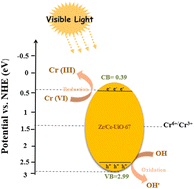One-step solvothermal synthesis of the bimetallic Zr/Ce-UiO-67 metal–organic framework: a visible-light-activated photocatalyst for Cr(vi) detoxification†
Abstract
The photocatalytic elimination of hexavalent chromium (Cr(VI)), which is known to be a dangerous heavy metal, has attracted attention from all around the world. In the current study, the Zr-UiO-67 MOF and three new bimetallic Zr/Ce-UiO-67 MOFs with various Zr-to-Ce ratios (1 : 0.5, 1 : 1.5, 1 : 3) have been synthesized through a one-pot solvothermal route. The high specific surface area, which results from long linkers (H2BPDC), and the excellent light utilization of Ce-based MOFs in addition to their great stability have made the structures a fine choice in the field of photocatalysis. Several characterization techniques were employed to confirm this hypothesis. The samples’ bandgap values were reduced from 3.81 to 3.13 eV by increasing the amount of Ce in the structure. Therefore, among the various mass ratios, Zr/Ce-UiO-67(1 : 3) displayed the highest photocatalytic Cr(VI) reduction efficiency (93%) under visible-light irradiation within 90 min. This enhancement in the photoreduction activity might be related to the addition of a high amount of Ce(NO3)3·6H2O, which results in numerous active sites for the redox reactions. In addition, compared with pristine Zr-UiO-67, the effect of the MMCT transition led to the superior separation and transmission of photo-induced charge carriers and a decreased recombination rate, which resulted in the great photocatalytic performance of Zr/Ce-UiO-67.



 Please wait while we load your content...
Please wait while we load your content...